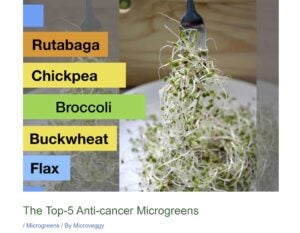Benjamin Franklin said that “nothing is certain except death and taxes.” If he were still around today, I’d humbly ask him to revise his statement: “Nothing is certain except death, taxes, and food fads.”
When I started writing about modern agriculture over a decade ago, I was already a hardened survivor of numerous food fads. In fact, that’s one of the reasons I started writing — it annoyed the crap out of me. But over the last 10 years, our society has continued to obsess over the latest and trendiest culinary products. Some are silly (read: non-GMO and superfoods). Others are just foods and nutrients that we should consume anyway (read: kale and fiber). And then there’s those that have ulterior purposes (read: organic and plant-based).
Welcome to the list, microgreens!
These teeny tiny little plants are a really big deal in the culinary world and home gardens right now. You’ve likely enjoyed them on top of an entrée or sandwich at your favorite restaurant.
But what are they, you ask? They’re actually just the seedlings of other edible vegetables and herbs, like arugula, beets, and kale. Growers just pick them very early in the plant’s life cycle.

Despite their itty-bitty size, they’re flavorful and pack a nutritious punch. Chefs like them for that flavor and visual appeal. Gardeners like how easy they are to grow and maintain. Dietitians like the vitamins and nutrients they boast (not to mention they’re vegetables). Specialty growers like the high price they fetch. And now it’s like the whole world is all about that #MicrogreenLife.
Likely one reason they’re so popular is due to how exclusive they are. Microgreens only remain fresh a short time after being harvested. That short shelf life limits their availability at grocery stores — and drives up their cost. So unless you’re a chef, you probably have to grow your own. No worries, because there exist countless online resources to help you get started.
But it shouldn’t come as any surprise that some clever charlatans have glommed onto the microgreen bandwagon to turn a pretty profit. There are the predictable claims that microgreens reduce inflammation, improve gut health, and cause weight loss. I’ve even seen websites boasting that microgreens can prevent chronic diseases and cancer.

Sure, microgreens are tasty and nutritious. But this isn’t a miracle food.
In fact, there are some problems with the microgreen revolution. Aside from the short shelf life, these plants are really, really, really small. They might be more nutrient dense, but you’re also not likely to eat a full vegetable-sized serving of them to make it count. And that expensive price tag means most people can’t afford to.
It also requires some work (and expense) to start your own garden. The plants generally require daily attention. And you can only harvest them once. That’s a lot for something so small.
Those downsides are no big deal if you’re willing to accept microgreens for what they are: a food fad. They aren’t going to save you from cancer, but they’ll be a flavorful addition to your steak. You probably won’t lose weight eating them, but at least you’re eating a new vegetable! And you’re not going to grow enough to skip the grocery store, but at least you can enjoy a new hobby.
Why do some people have to always ruin the fun in that?
I love trying new foods, sampling different flavors, and even cooking something exotic on occasion. It’s ok to do that without thinking that your efforts will change the world and save lives. Let’s just enjoy this culinary moment spotlighting microgreens, and not turn it into the next myth to bust.
Amanda Zaluckyj blogs under the name The Farmer’s Daughter USA. Her goal is to promote farmers and tackle the misinformation swirling around the U.S. food industry.



